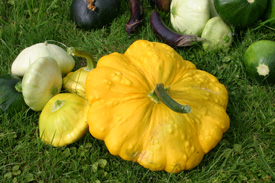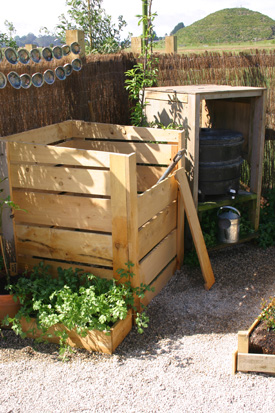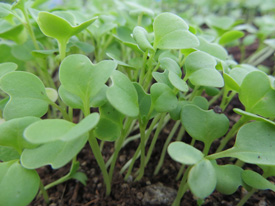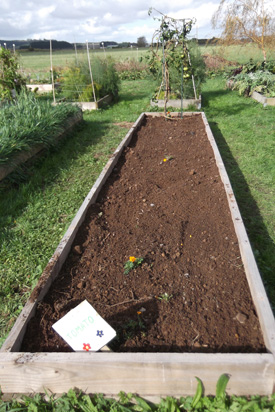Reap what you sow!
As the sun sinks lower in the sky, and you find yourself reaching for a jumper when evening closes in, autumn is beginning to make its presence felt.
After months of harvesting and processing, it may be with a sigh of relief when you notice the vegetable garden has peaked and starts to slow down. There are only so many zucchini you can eat! The freezer is full and couldn’t possibly fit another tomato, and every spare jar is filled with jams, pickles and chutneys.
At this time of year there is a strong temptation to down tools and walk away, promising yourself you’ll sort it out over winter. But really it is in your garden’s best interest to clear out the remains of summer and prepare for winter with the same care and attention you gave it in the spring.
The last of the summer harvest
If it’s time to clear the space and you still have green tomatoes clinging to the vine, you can harvest these. Hang the vines in a sunny greenhouse or put the fruit on a sunny window sill to ripen. Alternatively you could make fried green tomatoes or green tomato chutney. Nothing should go to waste in your garden!
Don’t pull out your beans, peas and other legumes – just chop them off at the base and dig the roots in, leaving them to break down. These will actually nourish the soil as legumes have nitrogen fixing nodules on their roots and will improve the quality of the soil.
As for those lingering summer crops, keep an eye out for that first frost as it will wipe them out overnight.
Building a healthy heap
Clear away the remains of each crop as it comes to an end. Put it on your compost pile so it can give back some of the nutrients it has taken from the garden over the long summer months. However, if the plants show any sign of disease, don’t put them on the compost. Put them in the bin. Adding diseased material to the compost pile risks spreading disease around your garden, as the next generation of bugs will be lurking in your lovely, nutrient, rich, dark compost. In an ideal world the compost heap heats up enough to kill said bugs, but in reality this is unlikely in winter unless your heap is huge.
So, in your efforts to clean up your garden, there are some things that are better off not being put in the compost. Tomatoes at the end of the season are more likely than not to be harbouring diseases which aren’t destroyed by the composting process. The risk is that tomato pests and diseases also attack potatoes, peppers and eggplants, which are all in the same family. Your plants may seem healthy enough, but it really isn’t worth taking the chance. Burn them (if the restrictions in your area allow) or throw them out with the household rubbish.
Layering it
With so much end of season debris at our disposal, this is a time when the compost pile can be filled quite quickly. For a beautiful, sweet smelling compost it’s important to keep the balance of green and brown material in proportion. You need about twice as much brown material as green. The brown matter provides the carbon element required and is generally in the form of twigs, and dry leaves. Paper will also help aerate the pile.
The green material comes from fresh leaves, grass clippings and kitchen waste. This provides nitrogen which creates heat as it breaks down, helping the composting process turn your garden waste into the nutrient rich compost.
Getting ready for winter
Once the garden is cleared, dig over your soil removing all traces of weeds and their roots. It is better to do this now before the soil becomes cold and wet in the winter. Digging sodden soil is very bad for it’s structure, besides which it’s simply not fun to be out there digging in the depths of winter.
You will want to use least some of your newly cleared space to grow some fantastic crops over the winter. For example, leeks, Brussels sprouts, silver beet, kale, broccoli, cabbage, cauliflower, turnips, beetroot, parsnips and carrots can all be sown now for winter meals.
Covering up
Nature doesn’t like bare soil and will attempt to fill the garden with weeds if left for long enough.
For areas not planted in winter crops, there are various ways to keep your garden relatively weed free over the winter. You can spread a thick layer of compost or manure – the deeper the better. During the winter the earthworms will do a lot of the work pulling it into the earth to improve the quality of your soil. Alternatively, you could plant a ‘green manure’ crop which will crowd out any weeds and then enrich the soil when you dig it into the garden in the spring.
Grow your own manure
Cover crops or ‘green manure’ crops, such as lupin, mustard, clover, lucerne, broadbeans and buckwheat are grown from seed sown in autumn. They add value to the garden in a number of ways:
- Most importantly a green manure crop will give your soil extra organic matter. As well as replenishing valuable nutrients that were taken away with last summer’s crops, the organic matter boosts the overall health of your soil and the vital microorganisms that live within it.
- Green manure crops provide organic matter in-situ; it’s so much easier and cheaper to scatter seeds across your garden than lug heavy bags of compost!
- Because the cover crop plants are grown quite densely, they’ll block the weeds.
- A green manure protects your soil from wind erosion and excessive winter rainfall.
- Instead of bare earth you’ll have attractive greenery to look at over the winter months.
How to grow a cover crop
- After the summer crops have been harvested, clear the garden of the old plants and any weeds.
- Dig over the soil and rake level.
- Depending on which cover crop you choose, scatter the seeds at a rate of about 50g of seed per square metre or check the specific instructions on the packet. For larger seeds, cover with a layer of soil.
- Water the seeds in well.
- Unless there is an exceptional dry period, this crop requires no special treatment as it grows through the winter.
- Once it begins to flower, or six weeks before you need to use your garden in the spring, whichever comes first, chop down your crop, with a sharp spade, weed eater, or even your lawn mower if your patch is particularly large.
- Dig all the stalks and leaves into the soil and leave it to decompose and release its nutrients.
- It is very important not to allow your cover crop to set seed or it will become a weed in your garden.
7-Mar-2014

Baby Squash


Cover Crop



